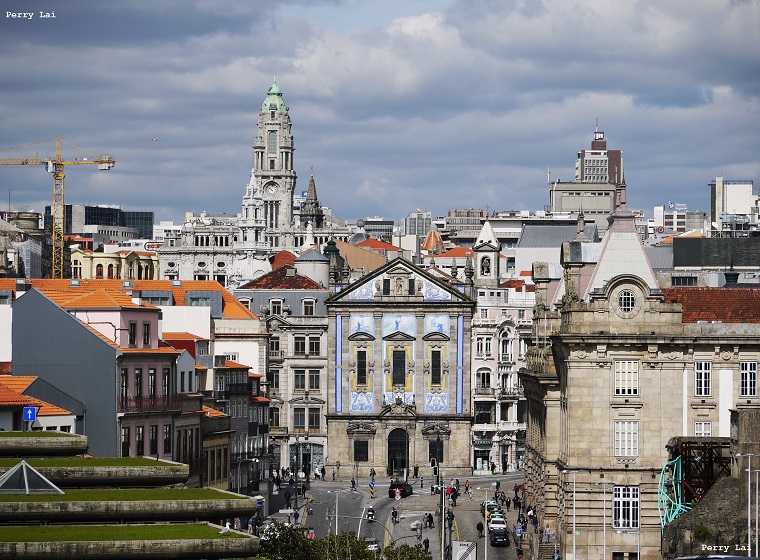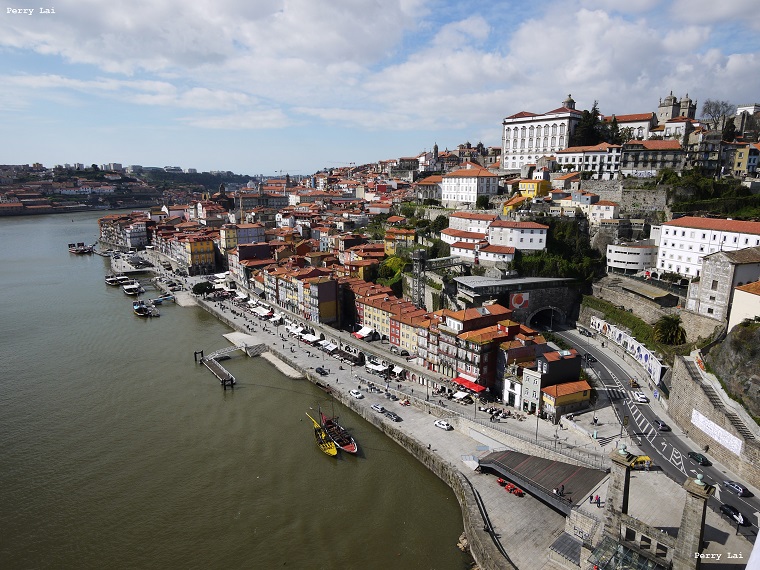Porto:
Igreja do Carmo. This church was built in the 1700's and is of the Baroque/Rococo style. It is connected to the Igreja dos Carmelitas, forming one volume, but two separate churches. This is the side wall covered with its blue and white tiles. Porto, Portugal.
Early morning on the intersection of R. Conde de Vizela and Rua dos Clérigos, looking east down Rua dos Clérigos. Porto, Portugal.
Clérigos Church Tower. It is a Baroque church built in the 1700's and the tower was the highest structure in Portugal when it was completed in 1763. Ships use to use it as a guide when coming into Cais da Ribiera. It is a prominent feature of the city skyline and it has become a symbol of the city.
Miradouro da Vitoria. A nice little scenic spot that overlooks the city and the cathedral. Found this place by accident, wandering around. Porto, Portugal.
Livraria Lello and Irmão. One of the oldest bookstores in Portugal. It was supposedly visited by JK Rowling while she was teaching English in Porto and might have been an inspiration for some of her Harry Potter writings. Porto, Portugal.
Inside Livraria Lello and Irmão looking up. The architecture inside the bookstore is of the Neo-gothic style. The stained glass has the Latin phrase, "Decus in labore," which means pride/honor/dignity in work. Porto, Portugal.
I liked how the buildings looked. They are so flat, colorful, and narrow. This is looking down Rua de Mouzinho da Silveira from the São Bento Train Station. Rua is street in Portuguese. Porto, Portugal.
Inside the São Bento train station. It is a historical station known for its tiles which depict scenes of the history of Portugal. Porto, Portugal.
One of the azulejo (tile) panels in the São Bento train station. This tiled wall picture shows the meeting of King Alfonso VII and the Crusader Knight Egas Moniz. Porto, Portugal.
I liked this picture because it's so busy. This is looking up Rua de Santa Catarina from the intersection of Rua de Passos Manuel and Rua de Santa Catarina. Porto, Portugal.
Majestic Café. It originally opened in 1921 under the name, Elite Café, and it was a meeting place for the finest members of society, where they could exchange ideas and discuss different topics over a cup of coffee or a cup of absinthe. Overtime, the place fell into disrepair and it wasn't until 1992 that they decided to bring the glamour back. After 2 years of reconstruction, they reopened the place in 1994. Majestic Café is decorated with the Art Nouveau style. Porto, Portugal.
Francesinha. A Portuguese sandwich originally from Porto. It's made with bread, wet-cured ham, linguiça (sausage), fresh sausage like chipolata, steak or roast meat, bread, topped with an egg, melted cheese, and a hot thick tomato and beer sauce over french fries. Café Santiago F, Porto, Portugal.
Casa Guedes. Small family-run place known for their pork sandwiches. Porto, Portugal.
Sandes de Pernil. Pork sandwich from Casa Guedes. Porto, Portugal.
Mercado Bolhão. Dates back to the 1800's, but the Neo-classic building was built in the 1900's. A 2-story marketplace with stalls selling fish, meat, bread, produce, souvenirs, flowers, and a few small restaurants. Porto, Portugal.
One of the produce stalls on the 2nd floor of Mercado Bolhão. Porto, Portugal.
Capela Das Almas. An azulejo-clad chapel. The tiles were done in 1929 by Eduardo Leite, depicting the death of St. Francis of Assisi and the martyrdom of St. Catherine. Porto, Portugal.
Confeitaria do Bolhão. Founded in 1896. A homemade bakery and pastry shop. Porto, Portugal.
Inside Confeitaria do Bolhão. Porto, Portugal.
Walking up to Porto Cathedral, you can see Saint Anthony's Church Congregados. The facade has Baroque features with tiles depicting St. Anthony and the Assumption of the Blessed Virgin Mary. Porto, Portugal.
View of the city from Porto Cathedral with the Clérigos Church Tower sticking out. Porto, Cathedral.
Porto Cathedral with its mix of Romanesque, Baroque, and Gothic style architecture. It was completed in 1737. Porto, Portugal.
From Porto Cathedral, we walked across the Dom Luís I Bridge to get to Vila Nova de Gaia, a city located south of the Douro river where all the cellars for the Port wine are. The Dom Luís I Bridge is a double-decked metal arch bridge that spans the Douro river, connecting Porto and Vila Nova de Gaia. The top deck is for the light rail and pedestrians, while the bottom deck is for automobiles and pedestrians. Porto, Portugal.
Casa Guedes. Small family-run place known for their pork sandwiches. Porto, Portugal.
Sandes de Pernil. Pork sandwich from Casa Guedes. Porto, Portugal.
Mercado Bolhão. Dates back to the 1800's, but the Neo-classic building was built in the 1900's. A 2-story marketplace with stalls selling fish, meat, bread, produce, souvenirs, flowers, and a few small restaurants. Porto, Portugal.
One of the produce stalls on the 2nd floor of Mercado Bolhão. Porto, Portugal.
Capela Das Almas. An azulejo-clad chapel. The tiles were done in 1929 by Eduardo Leite, depicting the death of St. Francis of Assisi and the martyrdom of St. Catherine. Porto, Portugal.
Confeitaria do Bolhão. Founded in 1896. A homemade bakery and pastry shop. Porto, Portugal.
Inside Confeitaria do Bolhão. Porto, Portugal.
Walking up to Porto Cathedral, you can see Saint Anthony's Church Congregados. The facade has Baroque features with tiles depicting St. Anthony and the Assumption of the Blessed Virgin Mary. Porto, Portugal.
View of the city from Porto Cathedral with the Clérigos Church Tower sticking out. Porto, Cathedral.
Porto Cathedral with its mix of Romanesque, Baroque, and Gothic style architecture. It was completed in 1737. Porto, Portugal.
From Porto Cathedral, we walked across the Dom Luís I Bridge to get to Vila Nova de Gaia, a city located south of the Douro river where all the cellars for the Port wine are. The Dom Luís I Bridge is a double-decked metal arch bridge that spans the Douro river, connecting Porto and Vila Nova de Gaia. The top deck is for the light rail and pedestrians, while the bottom deck is for automobiles and pedestrians. Porto, Portugal.
You get amazing views of Porto and Gaia from the top deck of the Dom Luís I Bridge. Porto, Portugal.
View of Porto from Gaia, with its colorful buildings, Praça da Ribeira, Clérigos Church Tower, and Porto Cathedral. Porto, Cathedral.
Port wine is named after Porto. In Vila Nova de Gaia, there are numerous port wine companies where you can tour their cellars and taste their wine. We didn't make any reservations for the tours. We walked into several of them, asked about their tours, and then decided on Sandeman.
Sandeman was established in 1790. The grapes for the port wine are grown in Douro valley and use to be transported to Porto via the Douro river using barcos rabelos, flat-bottom boats. Its not longer transported downriver since hydroelectric power dams were built in the 1950s and 1960s. Porto, Portugal.
Sandeman port wine cellar. The floor of the cellar is actually wooden blocks, and not bricks, which is what it may look like. Porto, Portugal.
Wine tasting after the tour. Port wine is typically sweeter, heavier, and higher in alcohol content than other wines. This is because port wine is fortified by adding distilled grape spirits, similar to brandy, to halt fermentation before all the sugar is converted into alcohol. Porto, Portugal.
Sandeman port wine tasting. Porto, Portugal.
Dusk at Gaia looking across the Douro river to Porto. Porto, Portugal.
Dusk along the Douro river with the Dom Luís I Bridge and Mosteiro de Serra do Pilar, a monastery, to the right. Porto, Portugal.
We walked back cross the Dom Luís I Bridge and had dinner at Restaurante Zé Bota. Medalhao a Ze Bota (sliced beef medallion), Bifinhos de Vitela com cogumelos (veal steaks with mushrooms), Bacalhau à braga (salt cod with cornbread), Bolo de agrião (watercress cake). Definitely tasted like home-style cooking. Porto, Portugal.
We walked back cross the Dom Luís I Bridge and had dinner at Restaurante Zé Bota. Medalhao a Ze Bota (sliced beef medallion), Bifinhos de Vitela com cogumelos (veal steaks with mushrooms), Bacalhau à braga (salt cod with cornbread), Bolo de agrião (watercress cake). Definitely tasted like home-style cooking. Porto, Portugal.
































